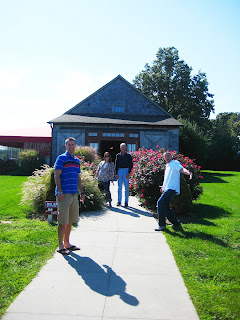It’s mid-October and the fall season is now fully upon us. To some that may mean winter and ski season are just around the corner, but to me, fall means FOOD. When I think of fall, I think of harvest and all the bountiful food that comes with it. To me, fall means cinnamon pumpkin pie, acorn squash drizzled with maple syrup, roasted corn on the cob, salty pumpkin seeds, shiny red candy apples, and of course, enough chocolate and candy to give you a stomach ache for two weeks. Fall is the one time of the year when eating is celebrated and gluttony is expected, and I love it!
Photo: Bountiful Harvest at Bayview Farms
Fall also means apple picking. Orchards brimming with bright red fruits entice even the most devoted city people to come out and enjoy the pleasure of harvesting their own food. The other week, while out the North Fork wine tasting with my boyfriend Kevin’s family, we passed an apple orchard. Kevin and I, and his sister Suzanne and her boyfriend Scott, pleaded like little kids with their dad, Clif, to stop the car. Although we didn’t go apple picking since it was already late in the afternoon, the conversation quickly changed to apples. We debated with great gravity whether apple cider tasted better warm or cold, which family member made the best apple pie, and what was the best variety of apples (Macoun was my choice!). “It would be so awesome if we had our own apple tree and could pick fresh apples whenever we wanted,” Suzanne thought aloud. “Yes! Let’s do it!” Scott interrupted enthusiastically. “We already have a mulberry tree growing in our backyard, so how hard could apples be?”
Photo: Wine Tasting on the North Fork
Well, my friends, I hate to break it to you, but growing an apple tree is not as easy as pie. Growing up, my family had a crabapple tree and a pear fruit tree in our backyard, planted by the previous owners. The crabapples were inedible, but the low-branching tree was great for climbing, so I was a bit upset when my dad cut it down when I was 10 years old. Not soon after, he also cut down the pear tree, which we were all glad to see go, since its fruits were brown and mushy and had the texture of gritty sand. In their place, my dad planted two spectacular apple trees – a rare ‘Early Blaze’ apple tree and a more popular ‘McIntosh’ apple tree. I remember being amazed that the white spring flowers could really turn into tiny little green fruits which got bigger and bigger and then suddenly turned a flushed red in the autumn. The first few years were great – we had enough apples for school snacks and my mom even made some delicious apple pies. I felt like we were real farmers and I bragged at lunch to my Garden City schoolmates that yep, I GREW this apple myself!
But like real farmers, our apple trees were not immune to pest problems. In the heart of the suburbs, it only took a couple seasons for the worms to find our apple trees. Our once crisp apples were now brown-spotted and distorted and were criss-crossed by brown twisted tunnels of rot on the inside. Tiny apple maggots had made our fruits inedible. Sometimes we’d cut open a seemingly healthy apple and inside was a large brown cavity of decay. The larvae of fruit moths were to blame. My dad tried spraying the trees with insecticides but nothing worked – the timing of the spray was incorrect or the insecticide he used wasn’t effective against the apple maggots and oriental fruit moths. Any healthy apples that did miraculously form, we couldn’t eat anyway until my mom meticulously scrubbed them of any trace of insecticide. Eventually my dad gave up on the apple trees, and the Alvey Fruit Farm was no more.
I now have a great appreciation for the orchard growers who supply our food stores and farms stands with fresh, healthy apples. I have an even greater appreciation for the fruit farmers who’ve decided to eliminate insecticide sprays and try other methods of pest control. How they get any healthy apples is a miracle in and of itself. So, Suzanne and Scott, my suggestion would be to stick to apple picking and leave the growing to the experts – getting healthy apples is not as easy as pie.
Places to go apple-picking on Long Island :
Wickham Fruit Farm – Cutchogue. 631-734-6441
Lewin Farms – Wading River. 631-929-4327
The Milk Pail – Water Mill. 631-537-2565
Baiting Hollow Nurseries – Calverton. 631-929-6439
Seven Ponds Orchard – Water Mill. 631-726-8015


